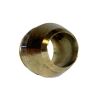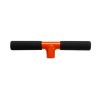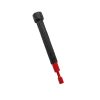AMS Soil Fertility Sampling Kits
Features
- Hammer-head cross handle and dead blow hammer are ideal for drier hard packed soils
- 10" handle available for softer, moist, or tilled soils
- Expedited repair and warranty service
- Lifetime technical support
- More
Overview
The AMS Soil Fertility Sampling Kits include a replaceable-tip soil probe (1" X 14" or 1-1/4" X 14"), along with a standard oversized tip, clay tip, mud tip, and a serrated tip. The four tips included in each kit will allow you to increase and improve your sample recovery in a variety of soil conditions.
Hammer-head cross handle and dead blow hammer are ideal for drier hard packed soils; use to pound soil probe into the soil. In softer, moist, or tilled soils, use the 10" handle and, if needed, the adjustable footstep. The slide hammer also allows you to reverse-hammer to assist in retrieving the sampler.
- (1) Soil probe with 12˝ sample slot
- (1) 10˝ cross handle with comfortable grip
- (1) Hammer head cross handle with dead blow hammer
- (1) 2' extension
- (1) Adjustable foot step
- (1) Soil ejector scoop
- (1) Cleaning brush
- (1) Spanner wrench
- (1) General purpose tip
- (1) Dry tip
- (1) Wet tip
- (1) Serrated tip
- (1) 1-1/4˝ x 18˝ triple lead flighted auger
- (1) Compact carrying case
In The News
Farmer-invented automated soil sampler reduces human error
A North Carolina farmer has developed a mobile soil sampling system with virtually no risk of human error, Southeast Farm Press reported. Allan Baucom, a grain and cotton farmer with more than 6,000 acres around Monroe, N.C., built the automated soil sampler to keep up with his expanding agricultural operations -- and growing variety of soil types. Named “the Falcon”, the sampler can take up to 12 samples and once, and store 200 before being unloaded. Two Falcons currently exist: one works Baucom’s farm, while the other operates on farms around the country to ensure the sampler’s efficiency in different environments. The sampler is expected to be made available soon, and will host new features, such as computer-interfaced electronic system for use with a laptop or tablet.
Read MoreAmazon sediment studied through Andes trip down tributary
A team of researchers led by scientists from the University of South Carolina Dornsife traveled to the Peruvian jungle to understand how sediment and plant matter travel down the Andes Mountains and into the Amazon River system, according a first-person account from Sarah Feakins, assistant professor of earth sciences at USC Dornsife. The team focused on a tributary to the Amazon River, the Kosnipata River. They started at the headwaters, traveling up treacherous gravel mountain roads. They ended in the Amazonian floodplain, where Feakins said the river was orange from colloids in the soil. The team spent most of their time collecting and filtering water to obtain sediment samples. Feakins described the work as collecting by day and filtering by night.
Read More50-year fertilizer study shows mixed results on soil quality
A new report authored by researchers from the University of Nebraska-Lincoln suggests that the use of inorganic nitrogen and phosphorus for fertilization improves crop yields, but can have negative impacts on soil quality, the American Society of Agronomy has reported. A study of crop lands in western Kansas has shown that inorganic fertilization increases organic carbon stocks while damaging soil’s structural quality. Researchers collected soil samples from experimental fields fertilized with various amounts of inorganic fertilizers to determine how different nutrient levels might impact soil quality. The results showed that applying nitrogen and phosphorus at high rates can expedite soil erosion and cause other structural issues.
Read More















